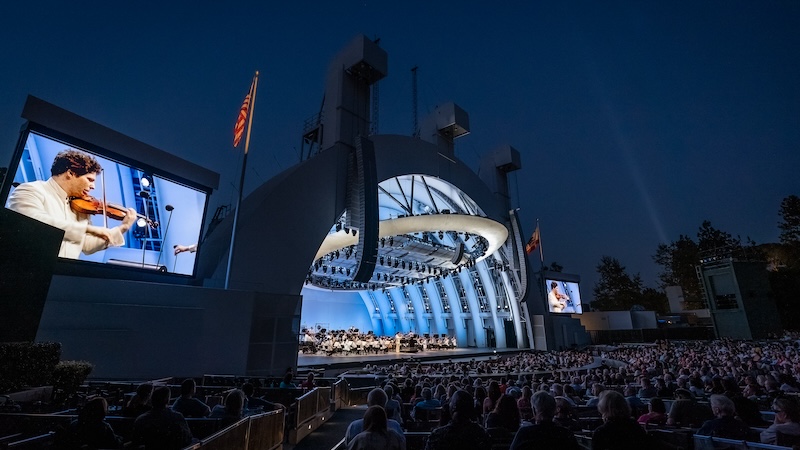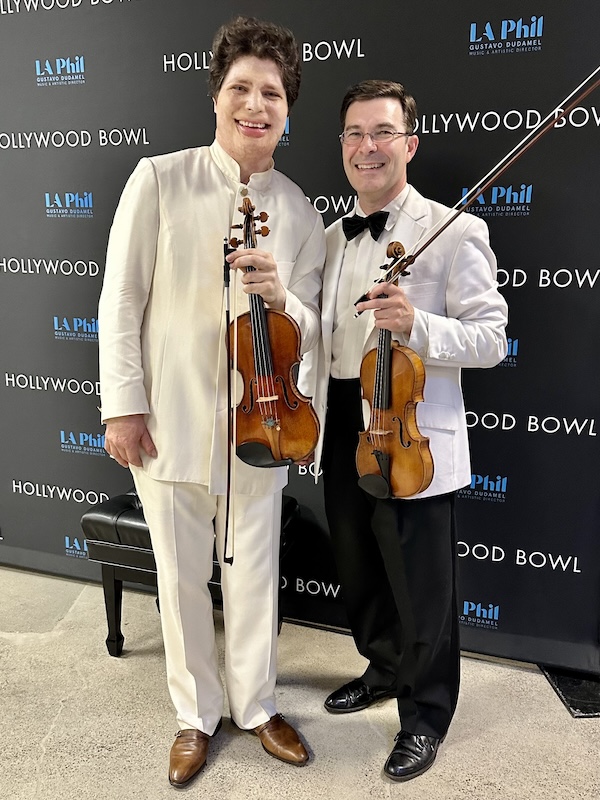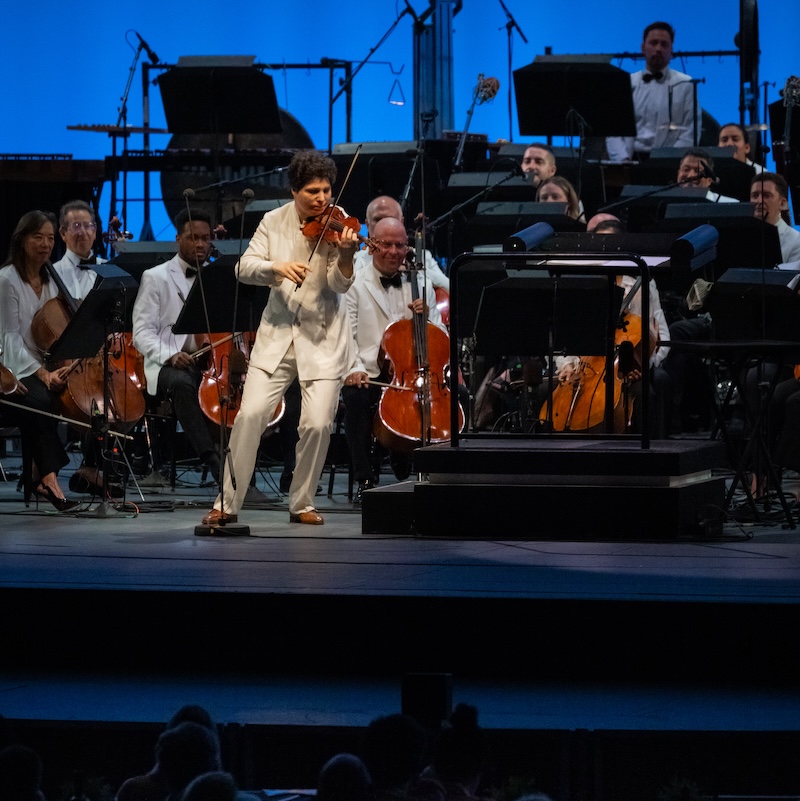REVIEW: Violinist Augustin Hadelich Performs Prokofiev 2 with the LA Phil
This summer's Hollywood Bowl season got off to a wonderful start on Tuesday with violinist Augustin Hadelich performing Prokofiev's Violin Concerto No. 2 with Los Angeles Philharmonic and conductor Elim Chan.

Augustin Hadelich performing at the Hollywood Bowl with the Los Angeles Philharmonic. Photo by Elizabeth Asher, courtesy of the LA Phil.
The concert kicked off what I might call a "summer of violinists," with July and August bringing a remarkable number of world-class violinists to the Bowl: Ray Chen playing Tchaikovsky, Pinchas Zukerman playing Mozart 3, Clara-Jumi Kang in Beethoven's Triple Concerto, Martin Chalifour playing Khachaturian, Karen Gomyo playing Bruch, Blake Pouliot playing Piazzolla, Joshua Bell playing "The Elements," Midori playing Dvorak and Leila Josefowicz playing Stravinsky.
Wow! (I have to note, though, LA Phil Music Director Gustavo Dudamel is not conducting for any of them!)
Violin fans had another reason to attend Tuesday night's concert - during the second half of the show, violinist Nathan Cole was sitting Concertmaster, playing the famous violin solos in Rimsky-Korsakov's "Scheherazade." It was one of a very limited number of concerts remaining, to see Cole perform with the LA Phil before he leaves for Boston, where he is transitioning into his role as the Boston Symphony Orchestra's new Concertmaster. For this concert he was sitting next to his wife, violinist Akiko Tarumoto - we will miss these Stand Partners for Life!

Violin soloist Augustin Hadelich and LA Phil Associate Principal Concertmaster Nathan Cole
The concert opened with Unsuk Chin's "subito con forza," a five-minute piece written in 2020 to commemorate Beethoven's 250th. The piece, which has some Beethoven references embedded, unfolds in gestures, alternating between periods of controlled chaos and more organized moments. There are special effects - col-legno, bells, piano, plinky sounds. The composer writes that she was aiming to illustrate sudden ("subito") changes and contrasts, and that came through.
Sergei Prokofiev's second violin concerto, from the early 20th century, was another animal altogether, though still a study in contrasts. It demands virtuosity but also musical range: illustrating beauty then defiance, sorrow then triumph. Hadelich's sensitivity to sound and expression, paired with his astonishing technical control made this piece especially well-suited for him.
The opening of the first movement requires the solo violinist to unspool a long thread of melody - beginning without any accompaniment from the orchestra. The intimacy of this introduction is a bit at odds with the vast nature of the Hollywood Bowl - an outdoor venue that seats some 10,000 people (on this night it was about half-full - anywhere else the same crowd would have felt overflowing!) It is so big that a classical concert requires considerable amplification, and much of the audience is so far from the stage that a half-dozen giant screens are needed to make the musicians visible.
It takes a minute to dial in to this setup, but then there are some real advantages: watching live and in real time, one can also benefit from the many camera angles - and Hollywood knows how to do camera angles. I'm ever-impressed by appropriate gaze of the cameras, highlighting just the right instrumentalist at just the right time.
Hadelich asserted his voice from the beginning, drawing a rich and burnished tone from the 1744 del Gesù violin that he plays (on loan from Tarisio Trust). I felt I was hearing voicing where I haven't before in this piece that is quite familiar to me - kind of a revelation. Of course, just when Prokofiev gets you bathing in beauty and lyricism the music goes prancing off mischievously, for these kinds of sudden transitions Hadelich's precision of pitch, rhythm and intentional collaboration with the orchestra worked well.

Augustin Hadelich performing with the Los Angeles Philharmonic. Photo by Elizabeth Asher, courtesy of the LA Phil.
The second movement offers such a beautiful melody, soaring in syncopation over plunky strings and woodwind accompaniment - the way Hadelich played it was simply arresting. The movement also has plenty of quick passagework that he tossed off with ease and remarkable speed. There was a lovely clarinet solo from the LA Phil's Burt Hara.
The rollicking last movement had that exciting feeling of a car careening around a tight corner on a high mountain ridge. Built into the energy is a kind of heart arrhythmia - it occasionally skips a beat or even flutters with a few extra ones while still going full bore. The soloist needs a lot of control to execute this kind of dizzy dance, and Hadelich laid it down like a boss. One never worries he'll fall off the side of a cliff.
As an encore, Hadelich delighted the crowd with his own arrangement of the "Orange Blossom Special" - a fiddle medley layered with double-stops and plenty of jaw-dropping pyrotechnics, and played with evident joy. (Surely he would would out-fiddle the devil down in Georgia, hands down!)
The second half of the program featured Nathan Cole performing the concertmaster solos in Scheherazade - a piece he also will perform tonight with the Boston Symphony at Tanglewood. And in fact, Cole also performed the solos with the LA Phil for a 2022 Hollywood Bowl performance (here's our review of that performance).
This piece truly jived with the evening's outdoor setting: a soft breeze rippled the flags flanking the stage as this gently rocking music, inspired by 1,000 Arabian Nights, told us a bedtime story as night fell.
Cole played the opening with ease, getting into the lilt of it. And in fact, there were so many notable solos in this performance - cellist Robert deMaine's sweet cello solos, and multiple beautiful solos by oboist Marion Arther Kusyk. In the second movement bassoonist Whitney Crockett played those long solos with well-controlled timing and poise, and clarinetist Hara's dynamic control and impeccable articulation stood out. Along with Cole's concertmaster solos, harpist Emmanuel Ceysson played in beautiful synchrony.
On occasion, group consensus was a bit tenuous - the third movement's unison melody in the strings could have been a bit more unified, and there were times when things simply didn't line up from the back of the orchestra to the front.
But overall it was a satisfying performance, and the orchestral moments toward end of Scheherazade were wonderful to behold - the larger-than-life, enormous swirling orchestral sound, followed by the single voice of the violin - a solo to "bookend" the tale.
You might also like:
- Nathan Cole Named Concertmaster of the Boston Symphony Orchestra
- Review: Violist Teng Li; Joshua Bell with the LA Phil at Hollywood Bowl
- Video Interview with Violinist Augustin Hadelich, Part 2: About 'del Gesù'
* * *
Enjoying Violinist.com? Click here to sign up for our free, bi-weekly email newsletter. And if you've already signed up, please invite your friends! Thank you.Tweet
Replies
This article has been archived and is no longer accepting comments.
Violinist.com is made possible by...
Dimitri Musafia, Master Maker of Violin and Viola Cases
International Violin Competition of Indianapolis
Violinist.com Holiday Gift Guide
Johnson String Instrument/Carriage House Violins
Subscribe
Laurie's Books
Discover the best of Violinist.com in these collections of editor Laurie Niles' exclusive interviews.

Violinist.com Interviews Volume 1, with introduction by Hilary Hahn

Violinist.com Interviews Volume 2, with introduction by Rachel Barton Pine







